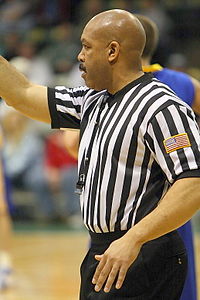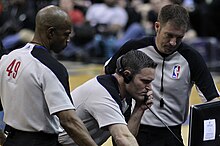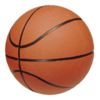Official (basketball)

In basketball, an official (also known as a Referee) is a person who has the responsibility to enforce the rules and maintain the order of the game. The title of official also applies to the scorers and timekeepers, as well as other personnel that have an active task in maintaining the game. Basketball is regarded as among the most difficult sports to officiate due to the fast speed of play, the complexity of rules that must be followed, the unique case-specific interpretations of rules, and the instantaneous judgement required.
Officials are usually referred to as referees; however, generally there is one lead referee and one or two umpires, depending on whether there is a two- or three-person crew. In the NBA, the lead official is called the crew chief and the other two officials are "referees".[1] In FIBA-sanctioned play, two-man crews consist of a referee and an umpire, and three-man crews contain a referee and two umpires. Regardless, both classes of officials have equal rights to control almost all aspects of the game. In most cases, the lead official (in FIBA, the referee) performs the jump ball to begin the contest, though NFHS and NCAA recently have allowed the referee to designate which official (referee or umpire) shall perform the jump ball.
Equipment
In American high school and college basketball, the officials generally wear black and white striped shirts with black side panels (as pictured above), black pants and black shoes. Some state high school association allow officials to wear grey shirts with black pin strips instead of the black and white striped shirts. NBA officials wear grey shirts with black slacks and black shoes. The NBA shirt is grey with black colored shoulders and sleeves, and the NBA logo above the breast.[2] The WNBA referee shirt is similar to the NBA referee shirt, except that its shoulder and sleeve colors are orange and the WNBA logo takes the place of the NBA logo.[3] FIBA officials wear a grey (torso) and black (sleeves) official referee shirt, black trousers, black socks and black shoes. Officials in competitions organized by Euroleague Basketball (company)—the Euroleague and Eurocup—wear an orange referee shirt. Officials in the Israel Basketball Association generally wear the Euroleague's orange uniform shirt, but on occasion don a royal blue referee shirt for contests between two Israeli teams. Most officials' slacks are currently belt-less, while most officials' shirts are collar-less, V-neck shirts.
All officials wear a whistle that is used to stop play as a result of a foul or a violation on the court. In all instances of officiating, hand signals are used to indicate the nature of the infraction or to administer the game.
In higher levels of college and professional ball, all officials wear a timing device on the belt-line called PTS (Precision Timing System). The device is used by on court officials to start and stop the game clock in a timely manner, rather than waiting for the scoreboard operator (Time keeper) to do so.
Positions and responsibilities

The officials must ensure that the game runs smoothly, and this encompasses a variety of different responsibilities, from calling the game to player and spectator management. They also carry a duty of care to the players they officiate and to ensure that the court and all equipment used is in a safe and usable condition. Should there be an issue that inhibits the safe playing of the game, then it is the job of the officials to rectify the problem. Quite often, the job of an official surpasses that of the game at hand, as they must overcome unforeseen situations that may or may not have an influence on the game.
There are two standard methods for officiating a basketball game, either "two-person" or "three-person" mechanics depending on how many officials are available to work the game. In "two-person" mechanics, each official works either the lead or the trail position. The lead position is normally along the baseline of the court, with the trail position having its starting point at the free throw line extended on the left side of the court facing the basket. Officials do change position a lot during the game to cover the area in the best possible way. As the game transitions from one end of the court to the other, the lead becomes the trail and vice versa. Between the two positions, each is responsible for a specific part of the court as well as two each of the side, base or back court lines. Officials change position after certain calls (mostly when the lead official calls a defensive foul). This allows officials to alternate between positions to increase the speed of play; one official will approach the bench whilst another, usually the closest to the bench at that time, will move to occupy his position. This also prevents one official from always working one particular team's basket throughout the course of the game.
In "three-person" mechanics, the court is further divided among three officials, with the lead (baseline) official determining the position of the other two officials. Normally, the lead official will move to the side of the court in which the ball is located (strong side), particularly if there is a "post-up" player in that position. The official that is on the same sideline as the lead official then takes up a position approximately level with the top of the three-point line and becomes the "trail" official, while the third official will stand across the court near the free throw line in what is called the center position. This creates a triangle coverage of the court. Often, the lead will switch sides of the baseline during a play, requiring the trail to move down to be level with the free-throw line and become the new center, while the center will move up and become the trail. As the ball moves to the other end of the court in transition, the lead will become the trail, the trail will become the lead, and the center official will remain in the centre (unless the new "lead" moves across the baseline to cover the strong side, in which case the center official and trail would then switch positions.)
Difficulty

Basketball is regarded[by whom?] as among the most difficult sports to officiate.[citation needed] Usually basketball officials have only a brief moment to determine if an infraction has occurred, due to the speed of play of the game and the officials' proximity to the action. Especially difficult is the "charge/block" call as to which player is responsible for contact. Officials often rely on instant replay to review plays.
Despite the misconception that basketball is a non-contact sport, officials often let a large amount of marginal or incidental contact pass uncalled. An official must always be wary of not just what is happening around the ball, but the roughness of play going on around the whole court, adding to the job of the official.
Further complicating the job of an official is the proximity to the crowds. Unlike football or baseball, the crowd is nearly always located within a few feet of the official, as are coaches and other players on the bench. To combat this, officials are able to remove a fan from the arena with an ejection.
Duties
Violations
When a violation occurs, game action is immediately stopped. These include traveling, illegal dribbles, out-of-bounds, and other violations. The official is required to blow the whistle and immediately stop play and award the ball over to the opposing team.
Fouls
A foul normally occurs when a player physically impedes the action of a player of the opposing team. Examples include blocking, hand-checking, illegal use of the hands and pushing, which is one of the more discretionary calls. A player may legally gain possession of a rebound over an opponent, provided they do not physically displace them. The proper foul, if one occurs in this situation, is normally a "push foul" for displacing the other rebounder.
If for some reason a player or team member (or in rare cases a spectator) behaves with disorderly or offensive conduct, officials often charge a technical foul or unsportsmanlike foul against that person. If a player or team member displays further inappropriate behavior, officials may eject the person from the court. This adds to the stress load of the official; these types of fouls often aggravate players and spectators, often resulting in rough play, leading to more technical fouls and/or ejections.[citation needed] Coaches, particularly in higher levels of basketball, will sometimes intentionally behave inappropriately in order to receive a technical foul, with the aim of "firing-up" players and spectators.[citation needed]
References
- ^ NBA Official Rules (2009–2010) Rule 2, Section I, a. Retrieved July 26, 2010
- ^ http://www.americanmemorabilia.com/Auction_Item.asp?Auction_ID=46719
- ^ http://phillyref.com/basketball/wnbarefs/lauren_holtkamp.jpg

